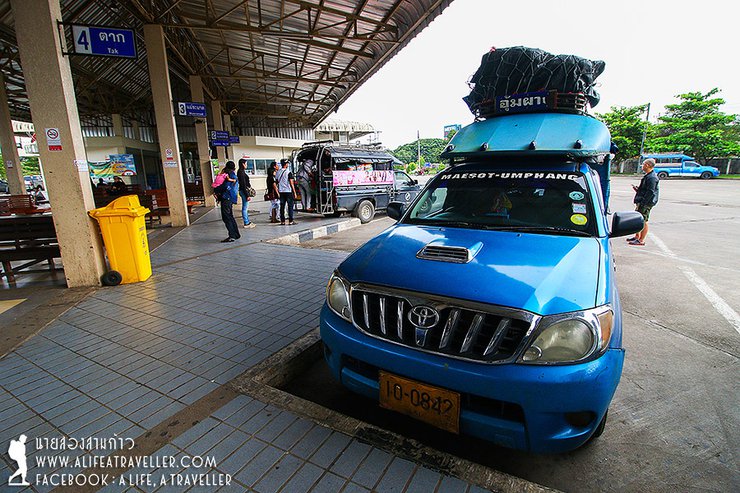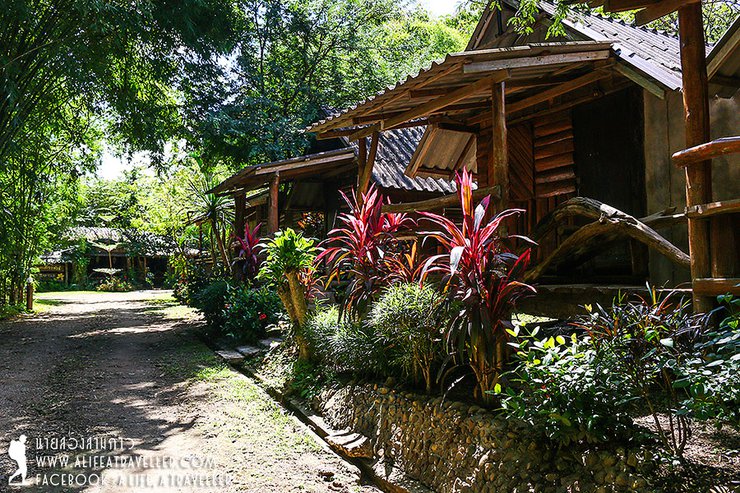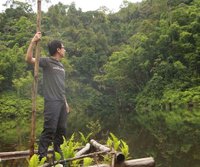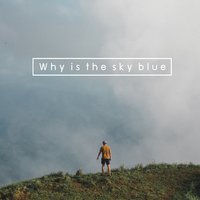A Long-Awaited Journey to Thailand's Grandest Waterfall
In the days of my nine-to-five existence, when the concept of "travel" was a distant dream, I embarked on a trip to Thi Lo Su Waterfall, nestled within the Umphang Wildlife Sanctuary in Tak Province, Thailand. Accompanied by a colleague, I witnessed the waterfall's magnificence and vowed to one day share this experience with my future partner.
Years later, with a wealth of travel experiences under my belt, I felt the time was right to fulfill that promise. This year, I decided to take "her" to witness the grandeur of Thailand's most awe-inspiring waterfall.
I happened to have a younger friend in a Facebook travel photography group who opened a coffee shop in Umphang. So I opened a chat to ask for advice because, as you know, backpacking in Umphang is quite difficult. Most of the time, you have to buy a tour per person, which wouldn't be feasible for just two people. It turned out that my younger friend had a close friend who owned a resort and tour guide named Dok Siew Tour, so they arranged everything for me.
"Come on over, brother. The resort has no customers. We'll take you on a tour ourselves. We're just itching to take some pictures," my junior said. As soon as we got this response, my wife and I rushed to pack our bags. (Haha…)
(1)
During the Piyamaharaj long weekend, I stayed in Korat. However, for convenience, I started my trip in Bangkok. I took a bus from Mo Chit to Mae Sot at 11:30 PM and arrived at my destination around 5:00 AM. I was surprised to see that the Mae Sot bus terminal was already crowded with people from Thailand, Myanmar, and Muslim communities, all traveling before dawn.


From Mae Sot Bus Terminal, there are shared taxis to Umphang every hour. The first one leaves at 7:30 AM, or earlier if it's full. The last one leaves at 2:30 PM. As soon as the bus arrived, I rushed to ask about the fare. I was told that it was 130 baht per person to sit in the back, and 150 baht to sit in the front next to the driver, which could accommodate two people comfortably. Out of concern for the well-being of my companion, I booked two seats in the front, as it would also help alleviate car sickness.

The distance from Mae Sot to Umphang is 150 kilometers, passing through a road with 1,219 curves. It is recommended that those who are prone to motion sickness take preventive medication beforehand. These are available for purchase at the Mae Sot Bus Terminal. Along the way, there will be a rest stop at Ban Umphing, Phop Phra District, where you can have a meal to satisfy your hunger. In total, it takes about four hours to reach Umphang by car.
The Mae Sot-Umphang Road, also known as the "Sky Road," offers breathtaking views like this one throughout its length.



At around 12:30 p.m., the songthaew dropped us off at our destination, "Dok Siew Tour." We told the driver where we were going, and if it was within the Um Phang area or not too far, he would take us there. The atmosphere of the accommodation was typical of Um Phang: simple, ordinary, but lush. Every room had a hot water heater, but air conditioning wasn't necessary here.




The young resort owner, a friend of my junior, greeted us warmly. After a short rest, he took us to his junior's coffee shop, called "Amo-Apa," which means "mother and father" in Karen language. The coffee here is strong and flavorful (I'm clearly biased). The atmosphere of the shop is pleasant, as the owner is an art student. In addition to various drinks, they also serve affordable rice with pork leg, beef noodles, and pork noodles.




After a brief chat, we set off for our evening destination: Doi Huamod. This mountain range stretches for several kilometers along the Umphang-Pa La-u-Kaeng Krachan Road. The most popular viewpoint among tourists is at Km 10. However, the highest point of the mountain is actually at Km 8. Here, you can park your car by the roadside and hike for forty minutes to reach a spot offering stunning views of both the sunset and sunrise.
Six individuals embarked on a challenging trek to the summit of Doi Huat Mod: myself, my girlfriend, her junior, her junior's friend, the resort owner, another friend of her junior's friend, and the latter's girlfriend. Despite the relatively low elevation, the ascent proved arduous due to the slippery gravel path, necessitating short, cautious steps and constant support.



The view was worth the climb, even though the desired evening light did not appear due to the large rain clouds that covered the sky. Nevertheless, the atmosphere was still beautiful.




After descending, take a quick detour to the walking street, located in the Soi Bhuddoi campsite. It's open every Friday and Saturday from late October to around March. Mostly it's food stalls, which is perfect for us to find some snacks to go with our beers... The rest, I think we can skip, right?
(2)
Waking up to fresh air and enjoying a hot bowl of rice porridge with toppings at Dok Siew Tour is a simple yet delicious way to start the day.

Today, our group of six set out for the Ti Lor Su Waterfall. As many know, the road from the entrance to the waterfall is 25 kilometers long. While it is possible to drive directly to the waterfall, for a more adventurous experience, we opted to raft down the Mae Klong River. We passed the Ti Lor Jor Waterfall, the Ta Khop Bi Rapids, and reached the Pha Lueat Ranger Station, which marks the halfway point. From there, we switched to a four-wheel drive vehicle for the remaining 10 kilometers.
This year, the road to Ti Lo Su opened in October (usually it opens in November). Due to the ongoing rainy season, the road is muddy and difficult to navigate. However, once the rainy season ends, the road will be smoothed out, and travelers will only have to contend with red dust.
Okay, let's start our journey by rafting. The owner of the Dok Siew Tour resort volunteered to be our guide. This son of Umphang has been guiding rafting tours since he was a boy.

The scenery along the way was breathtaking. Upon reaching Tee Lor Jor Waterfall, also known as the "Rain Curtain Waterfall," we waited for the sun to emerge, revealing a magnificent rainbow. Rainbows are only visible at specific angles during the morning hours and require clear skies. As a result, the winter months, when there is still water and clear skies, are the ideal time to visit Tee Lor Jor Waterfall. The rainbow in our photo was only partially visible due to the abundance of clouds.




We briefly stopped at the hot spring checkpoint, where there were small food stalls. During our visit, the river water level was high, causing it to overflow into the hot spring, making it impossible to soak. Normally, the water is clear and suitable for bathing.


After a short while, we arrived at a small rapid called Kaeng Takohbi, where we captured some exciting action shots.


Our boat arrived at the Pha Luek Wildlife Sanctuary in Umphang at 11:30 am. There were quite a few tourists. We weren't in a hurry, so we had lunch first. It was simple, but delicious.



After a satisfying meal, the team continued their journey. The inflatable boat's oarsman transformed into a four-wheel drive driver. The terrain was incredibly challenging, with some sections so muddy that it seemed impossible to pass. Credit goes to the driver, who has been driving up Doi Lo Su since he was 15, before he even had a four-wheel drive vehicle. Now, at 27, he has both experience and a better vehicle, making even the most difficult roads a breeze.



Upon reaching the headquarters of the Umphang Wildlife Sanctuary, only 1.5 kilometers remain for the trek to Tee Lor Su Waterfall. The journey is remarkably easy, thanks to the well-maintained concrete path. The short walk is effortless, allowing visitors to reach the destination without breaking a sweat.


The sight of Tealosu before me filled my heart with joy. Finally, I was able to bring her here to witness this spectacle with her own eyes.




In addition to the viewpoint, we can also walk along the different levels of the waterfall. However, it is important to exercise caution.



After taking photos and admiring the grandeur of Thi Lo Su until it was time to say goodbye, we drove straight back to the resort. By the time we arrived, the car was so muddy and dirty that we didn't know how we would ever clean it.
Note: For those who wish to stay overnight at Thi Lo Su, the Wildlife Sanctuary provides a clean and comfortable camping ground and bathroom facilities. In case of overnight stay, the driver will charge an additional fee of 500 baht per night. If I have the opportunity, I would also like to stay overnight to soak up the atmosphere. Moreover, it is the only way to witness the beautiful sunrise at the waterfall.


(3)
On the third day in Umphang, I was greeted with a delicious bowl of rice porridge for breakfast, a personal favorite that left me feeling energized and ready for the day ahead.

Today, our program is to explore the outskirts or other places in Umphang. There are many beautiful places besides Tee Lor Su.
The journey begins at Nong Luang Temple, where a small yet exquisitely crafted teakwood chapel stands as a testament to the region's limited number of temples. This remarkable structure has become a prominent landmark in the area.



The next stop is Tham Takohbi Cave, a designated forest park. The cave is 3 kilometers long. I once walked through it from one end to the other. Now, local youth are being trained as guides to take tourists to see the stalactites and stalagmites. This is a positive development.
We walked in for about 1 kilometer, admiring the beauty until we were satisfied, then we came back out. The generosity of the younger siblings is up to you.




After a quick bite of rice and coffee at Amo-Apa's shop, we continued our journey to Pah Lahd Waterfall, another national park in Umphang. Located in Pah Lahd village, about 20 kilometers from the district center, the road leading to the waterfall is a gravel path. Small vehicles are strictly prohibited.
Compared to Thi Lo Su, Pa La Ta Waterfall may be smaller, but when I visited, the water was abundant, making it equally beautiful and lush. Tourists stopped by to play in the water periodically. The atmosphere was pleasant, neither desolate nor overly crowded.




On the way back from Pa La-U Waterfall, we passed Doi Huai Mod and decided to climb to the top to wait for another sunset. However, it turned out to be a disappointment again. When we started walking, the sky was still clear, but as it started to get dark, the sky became overcast with the threat of rain, forcing us to descend quickly. Nevertheless, we were able to capture some beautiful photos from a different perspective.




Everyone was exhausted that night, so it was time to call it a night and get some rest. (Haha...)
(4)
Every time I have a wonderful and enjoyable trip like this, I always feel sad when it's time to go home.
On the last day in Umphang, my wife and I woke up before dawn to watch the sunrise at Doi Huamod. This time, we went to the viewpoint at Km 10, which was closer than before. As usual, there were many people there. However, the sun was shy and hid behind the clouds again.



Afterward, we prepared to return. The owner of the Dok Siew Tour resort kindly offered to take us to Tak city and showed us some interesting places along the way.
To avoid a lengthy journey, let's visit the three waterfalls on the way back. They are located in the Phop Phra district and can be accessed from the Mae Sot-Umphang road.
The first waterfall is Pa Wai Waterfall, located in Namtok Pha Charoen National Park. It is accessible from the Mae Sot-Umphang Road, 14 kilometers from Ban Chibabo. Visitors can park their cars and walk down to the waterfall easily. The waterfall consists of small limestone tiers that cascade down. While the waterfall itself is beautiful, the dark red soil makes the water appear less clear than it actually is.



Next is Pha Charoen Waterfall, the park headquarters. Those who visit Umphang often stop by on their way back. Currently, there is no entrance fee to the park as it is in the process of being established and has not yet been announced in the Royal Gazette.


The last waterfall is Thara Rak Waterfall, or its old name Pha Chan Waterfall. It is only a few hundred meters from the main road and is a community-managed waterfall. It falls from a single cliff face in an area with a parking lot and a pavilion for relaxing by the reservoir. It is relatively easy and comfortable to visit.




At the very end, if anyone wants to stop by the Rim Mae Market at the Thai-Burmese border to buy souvenirs, feel free to do so. The most prominent items are likely cosmetics and jewelry. I don't have any knowledge about their quality, so you'll have to judge for yourselves. As the saying goes, "A good eye gets, a bad eye loses."


As dusk settled, we arrived at Tak Bus Terminal. We boarded a bus to Phitsanulok, where we would transfer to another bus back to our home in Korat. This marked the end of our trip. I must say, it was a physically demanding journey, but also incredibly enjoyable. As you can see, we captured countless stunning images to cherish as memories.
Having made it all the way to Umphang, after conquering 1,219 curves, it's time to explore and experience all it has to offer. After all, Umphang is much more than just the stunning Thi Lo Su Waterfall.
Anyone interested in a thrilling trip to Umphang and Thi Lo Su Waterfall, please contact Dok Siew Tour for details. Phone: 089-860-5070, 089-958-9347 or visit their Facebook page at www.facebook.com/dokseawclub. Even without considering our personal connection, I can confidently say that their services are excellent and comparable to other providers.
Personal Reflections on Umphang
From now on, Umphang might become a frequent destination for me, rather than just a once-in-several-years trip. What started as a connection through a friend and a resort has now evolved into a simple "friendship" (laughs…).
Recommendations for Visiting Umphang
Note: The original text provided only includes personal reflections and does not contain any specific recommendations for visiting Umphang.
Unlike typical travel experiences, visiting Umphang doesn't involve simply driving in, finding accommodation on the spot, and deciding where to go on a whim. This approach is not particularly common.
The most popular option is to purchase a package tour with accommodation at a resort. These packages typically allow you to choose your starting point, with prices varying depending on the location. Packages typically start at 2,000 baht from Umphang, 2,500 baht from Mae Sot, and 3,500 baht from Bangkok. These prices are per person for groups of 8-10 people and may fluctuate depending on the number of days, destinations, meals, and group size.
For instance, when inquiring about the price of a three-day, two-night package at two different resorts, we may not be aware that the more expensive resort provides better quality meals, while the cheaper resort offers inferior food. Similarly, negotiating the package price could potentially lead to a reduction in the number of meals, a change in the type of food, or a decrease in the number of sightseeing locations.
For those who prefer independent travel, self-guided tours to Thi Lo Su Waterfall and Pha La Ta Waterfall (both unsuitable for standard vehicles) can be arranged through resorts and tour cooperatives. Prices for vehicles to Thi Lo Su start at 1,800 baht and may increase depending on road conditions (500 baht per night for overnight stays). Transportation to Pha La Ta costs around 800 baht. Rubber boat rentals to Pha Laeud cost approximately 2,500 baht per boat, including two paddlers. Meanwhile, easily accessible destinations such as Doi Huai Mod, Tham Takohbi Cave, and the Um Phang district itself can be explored independently.
It is important to note that most resorts in Umphang are simple and do not offer luxury amenities. Air conditioning is not available (as thick blankets are more desirable), and meals are not provided unless pre-arranged.
Follow my travel adventures on another channel:
http://www.facebook.com/alifeatraveller
นายสองสามก้าว / A Life, A Traveller
Friday, October 4, 2024 3:00 PM





















